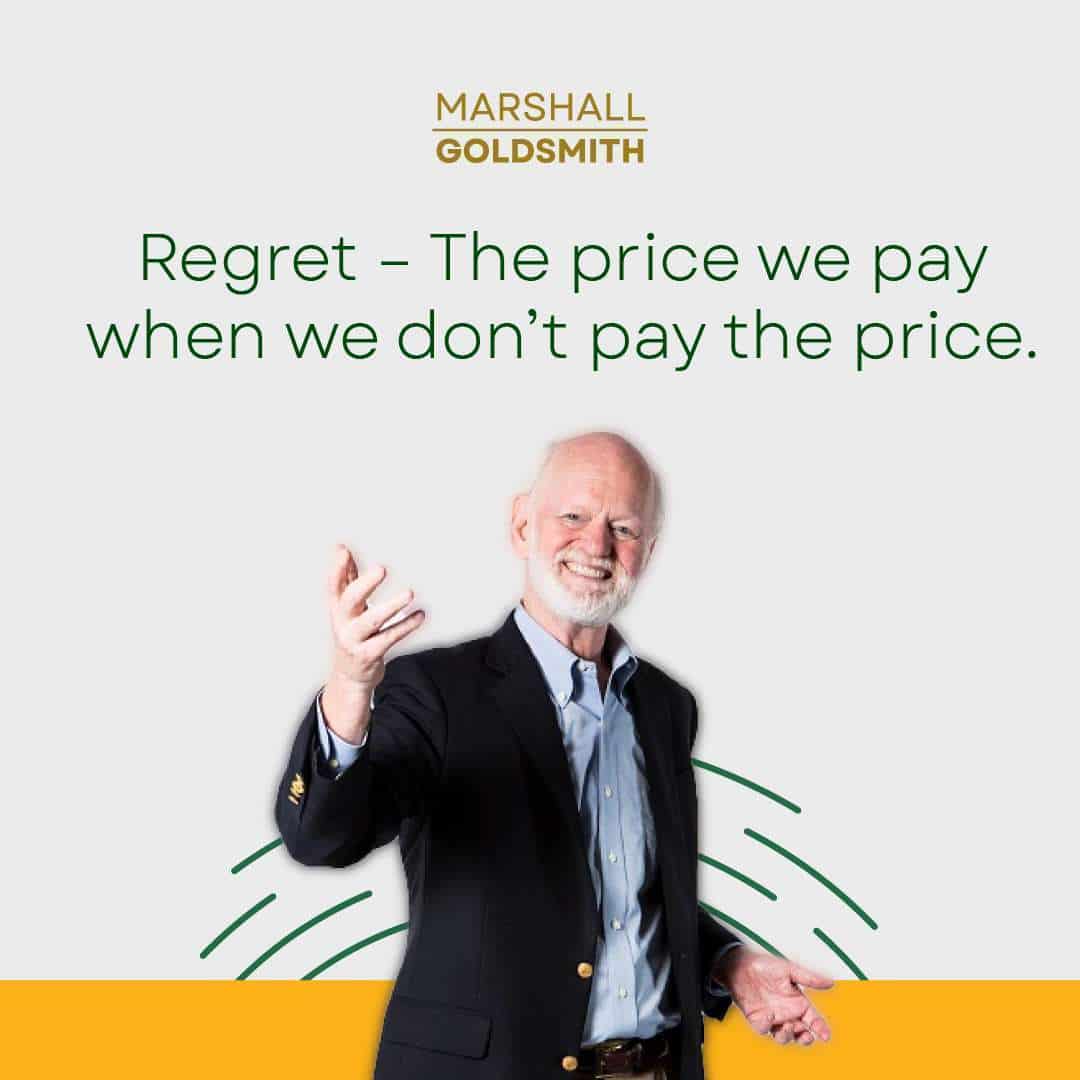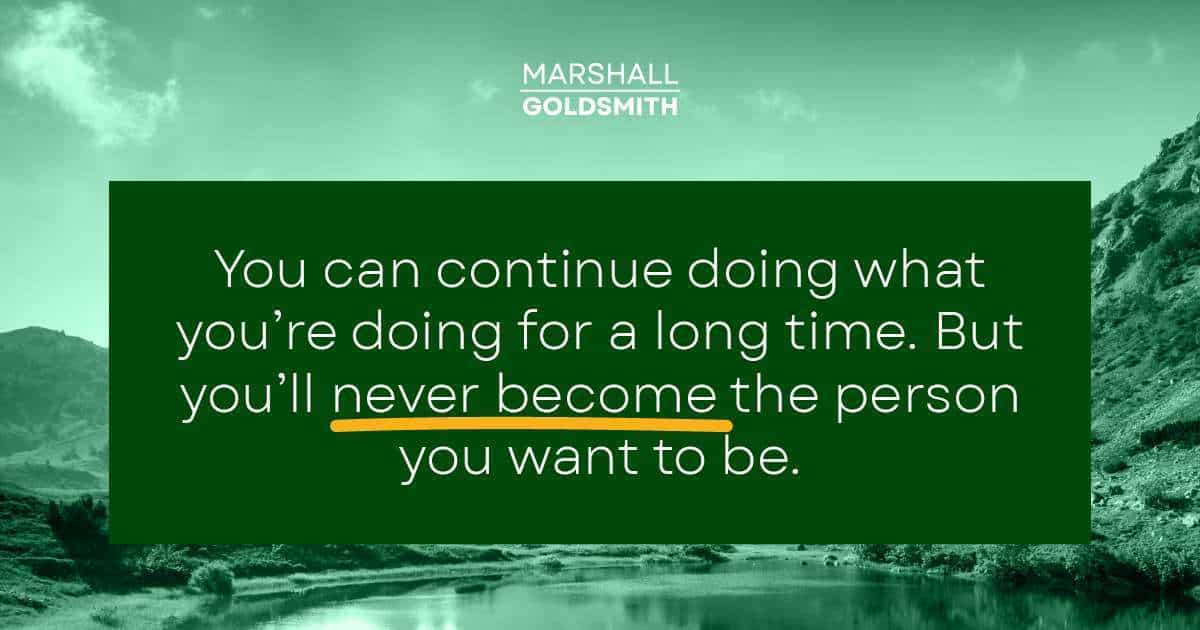Playing Favorites By Marshall Goldsmith There’s a reason I devote...
A review of research on goal-setting has helped us better understand two key areas of concern for leadership coaches: 1) Why people give up on goals and 2) How effective goal-setting can help ensure long-term goal achievement. An understanding of the dynamics of goal-setting and goal achievement may help coaches understand why their clients sometimes lose motivation and how they, as advisors in goal-setting, can increase the odds that their clients will “stick with the plan” and reach desired targets.
Why do people so frequently give up in their quest for personal improvement? Most of us understand that “New Year’s resolutions” seldom last through January – much less for the entire year! What goes wrong?
Six of the most important reasons that people give up on goals are listed below. Following each reason will be a discussion of implications for leadership coaches and ideas for “preventative medicine” in planning – so that clients will ultimately be more likely to achieve their change objectives.
Ownership
I wasn’t sure that this coaching idea would work in the first place. I tried it out – it didn’t do that much good. As I guessed, this was kind of a waste of time!

One of the biggest mistakes in all of leadership development is the roll-out of programs and initiatives with the promise that “this will make you better”. A classic example is the performance appraisal process. Many companies change their performance appraisal forms on a regular basis. How much good does this usually do? None! These appraisal form changes just confuse leaders and are seen as annual exercises in futility. What companies don’t want to face is the real problem – it is seldom the form – the real problem is the managers who lack either the courage or the discipline to make the appraisal process work. The problem with the “this will make you better” approach is that the emphasis is on the “this” and not the “you”. Coaching clients need to understand that ultimately only you can make you better.
Successful people tend to have a high need for self-determination. In other words, the more that leaders
commit to coaching and behavior change because they believe in the process, the more the process is likely to work. The more they feel that the process is being imposed upon them or that they are just casually “trying it out” – the less likely the coaching process is to work.
Coaches and companies that have the greatest success in helping leaders achieve long-term change have learned a great lesson – don’t work with leaders who don’t “buy in” to the process. As coaches, we need to have the courage to test our client’s commitment to change. If clients are just “playing a game” with no clear commitment, we need to be willing to stop the process – for the good of the company and for the good of the coaching profession.
In goal-setting coaches need to ensure that the change objectives come from “inside” the person being coached and are not just externally imposed with no clear internal commitment. Coaches need to let clients know that they are ultimately responsible for their own lives. As coaches we need to make it clear that we are there to help our clients do the work – not to do the work for our clients.
Time
I had no idea that this process would take so long. I am not sure that it is worth it!
Goal-setters have a natural tendency to underestimate the time needed to reach targets. Everything seems to take longer than we think that it should! When the time elapsed in working toward our goal starts exceeding expectations, we are tempted to just give up on the goal. Busy, impatient leaders can be even more time-sensitive than the general population.
While the “optimism bias” about time is true of goal-setters in general, it may be even more of a factor for leaders who are trying to change the perceptions of co-workers. In general, our behavior changes long before the perception of this change by our co-workers . We all tend to see people in a manner that is consistent with our previous stereotype – and we “look” for behavior that proves our stereotype is correct. Co-workers are no different than anyone else. Recent research shows that the long-term follow-up and involvement of co-workers tends to be highly correlated with changed perceptions of leaders . This is not something that is accomplished overnight. Harried executives often want to “check the box” and assume that once they understand what to do – and communicate this understanding to others – their problems are solved. If only the real world were that simple.
In setting goals with leaders it is important to be realistic about the time needed for them to produce a positive, long-term change in behavior. Habits that have taken 48 years to develop will not go away in a week. Let them know that others’ perceptions may seem “unfair” and that as they change behavior – others may not fully recognize this change for months. In this way when they face time challenges they will not feel like there is something “wrong” with them or with their co-workers. They will realize that this is a normal part of the change process. Ultimately, as the research shows, perceptions will begin to change and co-workers will begin to appreciate changed leadership behavior.
Difficulty
This is a lot harder than I thought it would be. It sounded so simple when we were starting out!
The optimism bias of goal-setters applies to difficulty as well as time. Not only does everything take longer than we think it will – it requires more hard work! Leaders often confuse two terms that appear to be synonymous – but are actually quite different – simple and easy. We want to believe that once we understand a simple concept, it will be easy to execute a plan and achieve results. If this were true everyone who understood that they should eat a healthy diet and exercise regularly would be in shape. Diet books are almost always at the top of the best seller lists. Our challenge for getting in shape – as well as for changing leadership behavior – is not understanding, it is doing!
Long-term change in leadership effectiveness requires real effort. For example, it can be challenging for busy, opinionated leaders to have the discipline to stop, breathe and listen patiently while others say things that they may not want to hear. While the leader may understand the need to change – and even have a great desire to change – it is still hard to have the discipline to change.
In setting goals it is important that leaders realize that real change will take real work. Making client’s feel good in the short-term with statements like “this will be easy” and “this will be no problem for you” can backfire in the long-term when they realize that change is not easy and that they will invariably face some problems in their journey toward improvement. Letting leaders clearly understand the price for success in the beginning of the change process will help prevent disappointment that can occur when challenges arise later in the change process.

Distractions
I would really like to work toward my goal, but my company is facing a unique challenge right now. It might be better if I just stopped and did this at a time when things weren’t so crazy.
Goal setters have a tendency to underestimate the distractions and competing goals that will invariably appear throughout the year. One good counsel that a coach can give an executive is, “I am not sure what crisis will appear – but I am almost positive that some crisis will appear!”
In some cases, the distraction or crisis may result from a problem – in other cases it may result from an opportunity. For example, mad cow disease was an unexpected problem that produced a crisis for executives in the meat packing industry. It is hard to focus on long-term leadership development when the company is going through an immediate financial crisis! On the positive side, “Cabbage Patch Kids” became a craze and the company started selling far more dolls than anyone imagined. It is hard to focus on long-term leadership development when your toy company has a “once-in-lifetime” short-term profit opportunity!
In planning for the future, coaches need to help executives assume that unexpected distractions and competing goals will occur. Build in time in change projections to “expect the unexpected”. By planning for distractions in advance, leaders can set realistic expectations for change and be less likely to give up on the change process – when either special problems or special opportunities emerge.
Rewards
Why am I working so hard at becoming a more effective leader? After all of my effort – we still didn’t make any more money this year!
Goal setters tend to become disappointed when the achievement of one goal doesn’t immediately translate into the achievement of other goals. For example, a dieter who loses weight may give up on his weight loss effort when women don’t immediately begin to love him.
Hewitt Associates has done some fascinating research that documents the positive, long-term relationship between investment in leadership development and long-term financial success . Their research shows that companies who invest in developing leaders tend to have greater long-term profits. There is no research that shows investment in developing leaders produces greater short-term profits.
Increasing leadership effectiveness is only one factor in an organization’s overall success. For example, a company may have the wrong strategy or be selling the wrong product. If someone is going down the wrong road – increasing people management skills will only help them get there faster!
Leaders need to personally “buy in” to the value of a long-term investment in their own development. If coaching clients think that improving leadership skills will quickly lead to short-term profits, promotions or recognition – they may be disappointed and may give up when these benefits don’t immediately happen. If coaching clients see the change process as a long-term investment in own development – and something that will help them become more effective over the course of their careers – they will be much more likely to “pay the price” needed to achieve success.
Maintenance
I think that I did actually get better when I had a coach, but I have let it slide since then. What am I supposed to do – work on this stuff the rest of my life?
Once a goal-setter has put in all of the effort needed to achieve a goal, it can be tough to face the reality of maintaining changed behavior. One of the first reactions of many dieters upon reaching their weight goal is to think, “This is great! Now I can start eating again. Let’s celebrate with some pizza and beer!” Of course this mind-set leads to future weight gain and the “yo-yo” effect that is unfortunately so common in dieters.
Coaching clients need to clearly understand – leadership is a process – not a state. Leaders can never “get there”. Leaders are always “getting there”. The only way that exercise helps people stay in shape is when they face the reality that “I have to work on this stuff for the rest of my life!” Leaders need to accept that leadership development is an ongoing process that never stops. Leadership involves relationships – relationships change and people change – maintaining any positive relationship requires ongoing effort over a long period of time. It doesn’t occur because someone “got better” and stayed in this state of “betterness” forever.
In Summary
Coaches can either help leaders set goals that increase their probability of long-term change, or help leaders set goals that may feel good in the short-term – but lead to disillusionment and “giving up” in the long-term.
The typical advertisement or “infomercial” – designed to help people “get in shape” – provides a great example of what not to do in goal-setting. The message is almost always the same, “For an ‘incredibly small’ amount of money – you can buy a ‘revolutionary’ product – that is ‘unbelievably easy’ and ‘fun to use’. This product will produce ‘amazing results’ ‘in almost no time’ and you will ‘have the body that you always wanted’.” Most infomercials imply that you will not have to continue exercising and diet for years – that you will continue to look young – and that you will have frequent, wonderful sex for the rest of your life.
In reality there is no “easy answer” – real change requires real effort. The “quick fix” is seldom a “meaningful fix”. Distractions and competing responses are going to happen – and the higher level the executive – the more likely that they will happen. Improving leadership skills – like getting in shape – won’t solve all of life’s problems. And finally great leadership is something that leaders need to commit to for the rest of their careers – at least if they really want to be great!
All of these messages may sound “tough”, but at least they are real. Successful people are not afraid of challenging goals. In fact – clear, specific goals that produce a lot of challenge – tend to produce the best results!
Coaches that have the courage to tell the truth “up-front” and challenge leaders in goal-setting can go beyond being “highly paid friends”. Honest, challenging coaches can help leaders make a real difference – both in their organizations and in the lives of the people they lead.
Marshall Goldsmith has recently been named by the American Management Association as one of the 50 great thinkers and leaders who have impacted the field of management over the past 80 years. Dr. Goldsmith has a Ph.D. from UCLA. He has been asked to teach in the executive education programs at Dartmouth, Michigan, MIT, Wharton, Oxford and Cambridge Universities. Marshall is the co-author or editor of 19 books including: The Leader of the Future (a BusinessWeek best seller), Global Leadership: The Next Generation and The Art and Practice of Leadership Coaching.
Kelly Goldsmith obtained her Ph.D. in Marketing from Yale University (2009). She begins her career as a marketing professor at the Kellogg School of Business at Northwestern. Her research focuses on how consumers’ goals affect their choices and behaviors. Specifically, her dissertation research focuses on how consumers make decisions under goal conflict.
Dr. Marshall Goldsmith was selected as the #1 Executive Coach in the World by GlobalGurus.org, and one of the 10 Most Influential Management Thinkers in the World by Thinkers50 in both 2011 and 2013. He was also selected as the World’s Most Influential Leadership Thinker in 2011. Marshall was the highest rated executive coach on the Thinkers50 List in both 2011 and 2013. What Got You Here Won’t Get You There was listed as a top ten business bestseller for 2013 by INC Magazine / 800 CEO Read (for the seventh consecutive year). Marshall’s exciting new research on engagement is published in his newest book Triggers (Crown, 2015).
Please order Triggers!

Adding Too Much Value Won’t Get You There By Marshall...
C-Suite Master Class: No, But, However By Marshall Goldsmith Continuing...
The Doerr Institute: Expanding the Market for Coaches By Marshall...
Making Leadership Development Part of the College Degree at Rice...
Sanyin Siang – Winner of the Thinkers50 Marshall Goldsmith Coaching...
Thinkers50 Marshall Goldsmith Distinguished Achievement Award in Coaching – Nominees...
Leading with Influence: What Is Influence360°? By Marshall Goldsmith Founder...
Are You a Dominator, Manipulator, Persuader or Influencer? By Marshall...
Leading with Influence: Redefining Modern Influence Part 2 By Marshall...
My mission is simple. I want to help successful people achieve positive, lasting change and behavior; for themselves, their people, and their teams. I want to help you make your life a little better. With four decades of experience helping top CEOs and executives overcome limiting beliefs and behaviors to achieve greater success, I don’t do this for fame and accolades. I do this because I love helping people!
As an executive educator and coach, I help people understand how our beliefs and the environments we operate in can trigger negative behaviors. Through simple and practical advice, I help people achieve and sustain positive behavioral change.